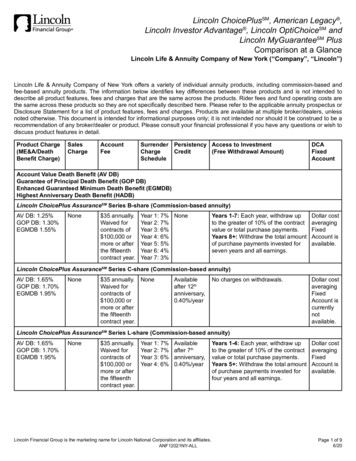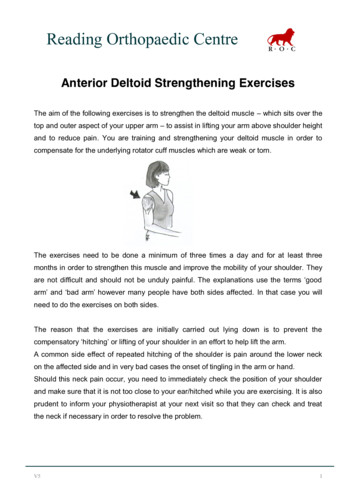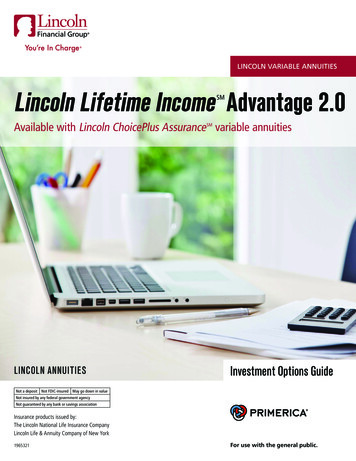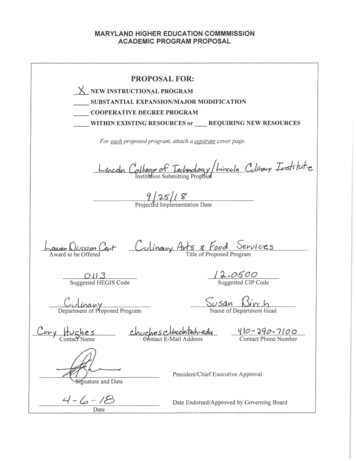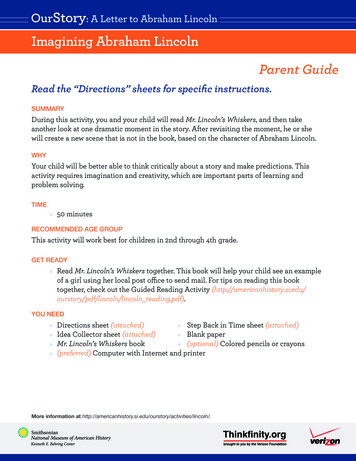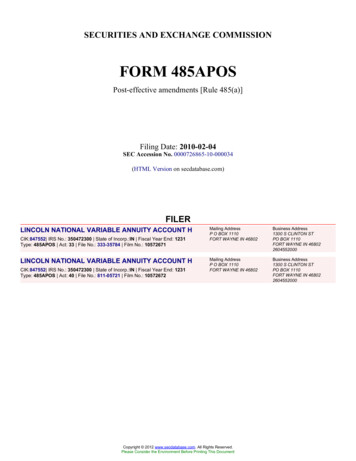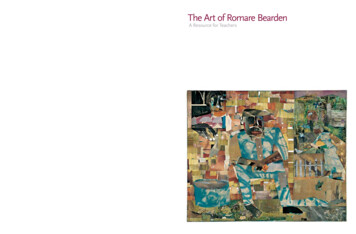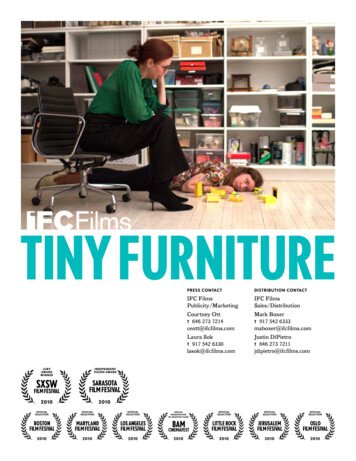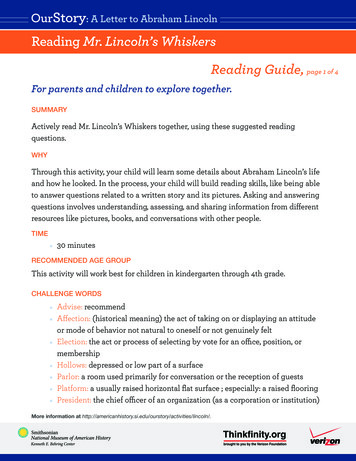
Transcription
OurStory: A Letter to Abraham LincolnReading Mr. Lincoln’s WhiskersReading Guide, page 1 of 4For parents and children to explore together.SUMMARYActively read Mr. Lincoln’s Whiskers together, using these suggested readingquestions.WHYThrough this activity, your child will learn some details about Abraham Lincoln’s lifeand how he looked. In the process, your child will build reading skills, like being ableto answer questions related to a written story and its pictures. Asking and answeringquestions involves understanding, assessing, and sharing information from differentresources like pictures, books, and conversations with other people.TIME 30 minutesRECOMMENDED AGE GROUPThis activity will work best for children in kindergarten through 4th grade.CHALLENGE WORDS Advise: recommendAffection: (historical meaning) the act of taking on or displaying an attitudeor mode of behavior not natural to oneself or not genuinely feltElection: the act or process of selecting by vote for an office, position, ormembershipHollows: depressed or low part of a surfaceParlor: a room used primarily for conversation or the reception of guestsPlatform: a usually raised horizontal flat surface ; especially: a raised flooringPresident: the chief officer of an organization (as a corporation or institution)More information at lincoln/.
OurStory: A Letter to Abraham LincolnReading Mr. Lincoln’s WhiskersReading Guide, page 2 of 4CHALLENGE WORDS usually entrusted with the direction and administration of its policiesRail-splitter: one that makes logs into fence railsSlavery: the state of a person who is a property of anotherTelegraph: an apparatus for communication at a distance by coded signals;especially: an apparatus, system, or process for communication at a distanceby electric transmission over wirePARENT PREPARATION If you have time, read the story yourself before sharing it with your child. Alsoread the Step Back in Time sheets and the notes on the last page of the book.If you have time, preview some of the reading suggestions below. Pick just afew suggestions that look interesting and fun for you.YOU NEED This reading guideStep Back in Time sheets (attached)Mr. Lincoln’s Whiskers book written by Karen WinnickDURING READING Build Vocabulary! You might not know all of the words that are used in thisbook, so you have the chance to learn some new words! If you come across aword you don’t know, here are a few ways to figure out what it means: Look at the whole sentence where you see the word. Try to figure outwhat the word means based on what the sentence is talking about. Look at the picture to see if there is an image of the word. For example,maybe you don’t know the word “parlor,” and the sentence says, “Thefamily sat in the parlor.” Look at the picture on that page to examine thelocation of the family—that might be what a parlor looks like!More information at lincoln/
OurStory: A Letter to Abraham LincolnReading Mr. Lincoln’s WhiskersReading Guide, page 3 of 4 Ask a parent, teacher, or friend. Look the word up in a dictionary. There might be more than one definition,so see which one fits best with the sentence you’re reading. Guess What Happens Next! It can be a lot of fun to try to guess what willhappen next in the story. During exciting parts of the story, try asking yourselfwhat will happen next, then keep reading and find out if you were right. Hereare some good spots to try this: After Grace talks to her brothers at dinner, what will happen next? After Grace sees the shadow on the poster of Mr. Lincoln, what will she donext? After Grace returns to the post office after mailing her letter, will Mr. Lincolnever write back? After Grace gets Mr. Lincoln’s letter in the mail and before she reads it toher family, what do you think the letter will say? When Papa and Grace’s brothers go to vote, will Mr. Lincoln win the electionor not?How Does Grace Feel? Grace Bedell is the main character in this story. Shefeels a lot of different emotions during the story. Try to find those emotionsthrough the words of the story or the pictures. If it doesn’t say what she’sfeeling, guess her feelings based on what’s happening in the story. How doesGrace feel . . . . . . when she gets the poster from Papa? . . . after talking to her brothers at dinner? . . . on her way to the post office to mail her letter? . . . after talking to Mr. Mann at the post office and sending her letter?More information at lincoln/.
OurStory: A Letter to Abraham LincolnReading Mr. Lincoln’s WhiskersReading Guide, page 4 of 4 . . . as she is running home from the post office with Mr. Lincoln’s letter?. . . when her brothers and Papa go to vote on election day?. . . as she waits in the crowd at the train station?. . . after Mr. Mann tells her Mr. Lincoln wants to meet Grace?. . . when she meets Mr. Lincoln and sees his new whiskers?What if . . .? The characters in Mr. Lincoln’s Whiskers make some importantchoices during the story. After reading the whole story, think about some ofthe choices the characters made and guess what might have happened if theyhad chosen differently. For example, what if . . . . . . Grace decided not to send her letter? . . . Mr. Lincoln didn’t write back to Grace? . . . Mr. Lincoln didn’t grow whiskers?More information at lincoln/.
OurStory: A Letter to Abraham LincolnReading Mr. Lincoln’s WhiskersStep Back in TimeFor more information, visit the National Museum of American History Web ies/lincoln/.Abraham Lincoln was the president of the UnitedStates of America from 1861 to 1865. As a child, hegrew up in a poor family and wasn’t able to spend muchtime in school because he had to work to help supporthis family. Abraham Lincoln is famous for leadingAmerica through the Civil War, freeing slaves, andgiving thoughtful speeches, like the GettysburgAddress. To find out more about Abraham Lincoln, n wore high top hats, likethis one. The last time he put iton was to go to Ford’s Theatreon April 14, 1865, the night hewas assassinated.Lincoln grew up in the woods. People who wanted him tobecome president talked about his job as a rail-splitter toshow that he was a hard worker and was like a lot of othernormal Americans.“Passage Through Baltimore”Etching by Adalbert JohnVolck, 1863. [National PortraitGallery, Smithsonian Institution]
OurStory: A Letter to Abraham LincolnReading Mr. Lincoln’s WhiskersFor Teachers, page 1 of 2Read the “Reading Guide” sheets for specific reading tips.OBJECTIVESThe students will be better able to: read for understanding.answer questions using written and image resources.recall one or more fact about Abraham Lincoln’s life and/or appearance.recognize images of Abraham Lincoln by his beard, hat, or height.STUDENT PERFORMANCE CRITERIA Discussion exhibits understanding of story and historical details.Discussion exhibits understanding of vocabulary in the context of the story.STANDARDSNCHS History StandardsK-4 Historical Thinking Standards2D: Read historical narratives imaginatively.2H: Draw upon the visual data presented in photographs, paintings, cartoons, andarchitectural drawings.3C: Analyze historical fiction.3F: Analyze illustrations in historical stories.3I: Challenge arguments of historical inevitability.3J: Hypothesize the influence of the past.K-4 Historical Content Standards4C: The student understands historic figures who have exemplified values andprinciples of American democracy.More information at lincoln/.
OurStory: A Letter to Abraham LincolnReading Mr. Lincoln’s WhiskersTeacher Guide, page 2 of 2IRA/NCTE Language Arts Standards1.Students read a wide range of print and nonprint texts to build an understanding oftexts, of themselves, and of the cultures of the United States and the world; toacquire new information; to respond to the needs and demands of society and theworkplace; and for personal fulfillment. Among these texts are fiction andnonfiction, classic and contemporary works.7.Students conduct research on issues and interests by generating ideas andquestions, and by posing problems. They gather, evaluate, and synthesize data froma variety of sources (e.g., print and non-print texts, artifacts, people) to communicatetheir discoveries in ways that suit their purpose and audience.21st-Century SkillsLearning and Innovation SkillsCritical Thinking and Problem SolvingInformation, Media, and Technology SkillsInformation LiteracyMore information at lincoln/.
OurStory: A Letter to Abraham Lincoln Reading Mr. Lincoln's Whiskers Read the "Reading Guide" sheets for specific reading tips. OBJECTIVES The students will be better able to: read for understanding. answer questions using written and image resources. recall one or more fact about Abraham Lincoln's life and/or appearance. recognize images of Abraham Lincoln by his beard .
